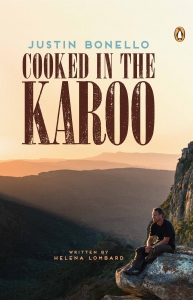
I’ve worked on a number of books this year, but one of my favourite favourites has to be Justin Bonello’s Cooked in the Karoo. This is the second Justin Bonello book I’ve edited for Penguin and when the raw text arrived via email in April, I couldn’t wait to tuck in.
I love working on Justin Bonello cookbooks – not only because his writing and design teams are so professional; not only because every recipe I read has me reaching for my shopping list so I can try making macadamia nut brittle or prickly pear ice lollies or roosterkoek, but because these books show me parts of Africa I haven’t discovered yet, and make me think (really think) about what it means to live here.
Justin Bonello’s eighth cookbook, like any Bonello book, is more than a collection of recipes. Cooked in the Karoo is a travelogue – but it’s more than that too. It’s not simply a document of what Justin Bonello and his team got up to in the two years that they wandered the area. Cooked in the Karoo is an appeal to South Africans to get out there and experience the breathtaking beauty of this semi-desert for ourselves.
In the foreword, Justin speaks about visiting an abandoned house in Aberdeen, where someone had scribbled on the wall, ‘Ek het gif in my gespuit. Moenie worry nie. Ek gaan maar dood in die dorp. Ek kon nie anders nie. Bye almal.’ ['I injected poison into myself. Don't worry. I'm going to die in town. I had no choice. Bye, everyone.'] It’s a heartbreaking story that speaks to the harshness of the Karoo, but this is where Justin’s journey began – he wanted to know more.
Beyond the barren landscape are big skies (and in Sutherland, specifically, you’ll find the largest telescope in the southern hemisphere). At the end of dusty roads are farms where visitors are welcomed, where ‘hospitality is a way of life’. In high-up caves are the paintings, rock art and artefacts of Africa’s ancestral tribes. In the veld and dried-up riverbeds are fossils that are 250 million years old.
It is here where Justin Bonello says he found himself. As one farmer described it, ‘The Karoo is a place where God comes to think.’
The Karoo is also a practical place, where people follow a waste-not-want-not philosophy. As city slickers, we’re a bit disconnected from where our food comes from and it’s good to be reminded. In the Karoo, what struck Justin strongly was the respect farmers have for the animals they slaughter: ‘If you’re going to kill an animal as a source of food, show it the respect it deserves and use every part of it.’ And they do use everything – from snout to tail.
Karoo cookery is just as practical. Preparing food in temperatures that range from 40 degrees Celsius during the day to below freezing at night means that fancy food is often a flop. Instead, Karoo cooking is just good, simple, down-to-earth deliciousness. The recipes in Cooked in the Karoo reflect this – they’re not hard, and they focus on humble food.
Page through this book and learn how to debone and butterfly a leg of lamb, how to cook lamb ribs between two igneous rocks, how to make goat sausages from scratch, how to train an Anatolian sheepdog to protect a herd of sheep, and how to survive in the Karoo (yes, there is a useful two-page survival guide).
Cooks can also learn how to make buttermilk, slaphakskeentjies, ricotta, hertzoggies, lamb chop broth, braaied Wellington, peach dumplings, springbok shanks, ash bread, ginger beer, frikkadelle, burnt sugar sweets, and other Karoo treats.
Is your mouth watering yet? It should be.
Content provided courtesy of To the Letter.
For more information on this title, please click here.






